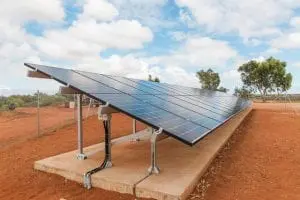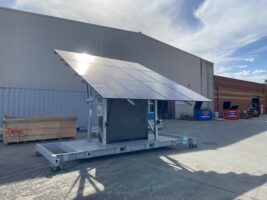Let me tell you about my morning.
I got up, turned the bathroom light and fan on, had a shower, dried my hair and then used the straightening iron to get rid of the annoying kinks. Bedroom and hallway lights went on before I fired up the oil heater in my daughter’s room, which is always quite chilly in winter despite the insulating layer of boy band posters on the wall.
I stoked the fire and put the fan on, Red Symons started squawking from the radio, the microwave pinged as three bowls of porridge were cooked, a load of washing went on and the fridge opened and
closed a dozen or so times while I made school lunches.
Now, I won’t continue to bore you with the minutiae of our typical weekday routine because I’m sure you get enough of that from your more annoying Facebook friends.
The point I’m trying to make is that we’re an average family doing everyday things. The only difference between your morning and ours is that you’re probably pulling your power from the grid.
Generally, when I tell people that our family-sized, 38 square home in semi-rural Little River, west of Melbourne, is completely solar powered, they think I mean we feed power back into the grid. Others, once I’ve explained that we have no physical grid connection, don’t quite believe it’s possible to have total freedom from energy costs.
And, strictly speaking, it’s not. But it is possible to have freedom from energy companies.
In 2012 when we started to build on the 17 acres we’d purchased in Little River six years earlier, it marked the start of our off-grid adventure. We’d spent considerable time trying to find an alternative to a grid connection quote upwards of $30,000 for a new power pole, 400 metres of trenching, conduit and cabling with the added cost of ongoing quarterly power bills.
The answer lay in 30 shiny PV panels (total of 5.5kW), a main AC switchboard Selectronic SP Pro 7kW inverter charger, a Kaco 6002 5kW inverter and a 24 cell 48v flooded lead acid (FLA) battery bank.
It’s a beautiful thing, this grouping of parts and components that, when connected as a whole, creates a perfectly serviceable personal power station. For me, helping to lug each battery cell into place in our garage – literally, a tonne of weight in total – it represented a lifestyle I wanted and that other people tell me they dream of.
But before I get carried away with rose-tinted poetic musings of energy autonomy, I must explain that this off grid goodness isn’t for everyone.
Our system cost $60,090, with around $7500 in government rebates for selling our renewable energy certificates (RECs) so someone else could pollute with impunity. Not ideal, but hey, a mortgage is a mortgage.

And it took a bit of getting used to. In fact, for the first few months my husband and I had minor anxiety attacks every time the kids wanted to switch the TV on. A path was worn from the living area to the mud room where the wall mounted battery monitor is, checking and rechecking battery state of charge (SOC) before giving our permission for the Dr Who DVD box set to go on. We could have connected a back-up generator, but just didn’t have the money at the time (did I mention the mortgage?) so were ultra careful to not let the SOC drop too low in order to help prolong battery life.
Pretty soon though, the anxiety wore off and the expense was tucked away on our home loan, which we’ll hopefully pay off before retirement. These days, almost two years on, we consume power like everyone else; on demand. And we still haven’t connected that back up generator, because we just don’t need it.
I consider people like my family and others in Australia to be the off-grid solar guinea pigs. And not tie-dye wearing, dread-locked guinea pigs either. The off-gridders I’ve spoken to are business suit-wearing teachers, civil servants, builders, engineers and journalists and I’m yet to hear any of them say they’ve compromised their lifestyle to live this way.
While off-grid isn’t yet viable for most, here’s my two cents worth; despite the damage our federal government is doing to the renewables sector, the cost of storage will eventually reduce enough for all those people dreaming of freedom from energy companies. We’ll see an explosion in consumers rethinking their energy consumption and their reliance on the grid.
Whether this takes the form of stand alone systems or community based storage banks, the future of affordable off-grid living is now being shaped. And I look forward to you joining us.











